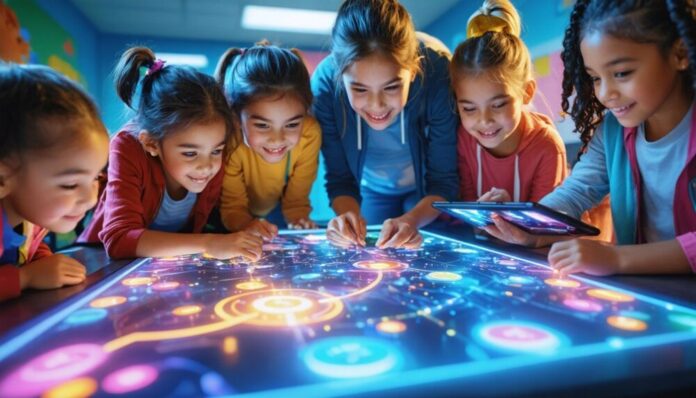Gamification enhances student learning by integrating game mechanics into educational frameworks. This approach increases motivation and engagement, with students reporting a 14% rise in participation. It also improves knowledge retention, allowing learners to retain up to 90% more information compared to traditional methods. Furthermore, gamified environments foster collaboration and self-efficacy, enriching the learning experience. Such advancements signify a promising direction for educational practices, leading to deeper insights into the effectiveness of gamified learning methods.
Highlights
- Gamification increases student motivation and engagement, leading to a 14% rise in participation in STEAM activities.
- Instant feedback and scoreboards enhance self-efficacy, improving students’ attitudes and confidence in their learning journeys.
- Students retain 22% more information through gamified solutions, significantly enhancing knowledge retention compared to traditional methods.
- Structured challenges and game mechanics cater to diverse learning styles, promoting cognitive development and interactive learning experiences.
- Collaborative gamified tasks foster social learning dynamics, with 67% of middle schoolers preferring teamwork in gamified environments.
The Role of Gamification in Education
As educational institutions increasingly seek innovative ways to engage students, gamification emerges as a vital mechanism in enhancing the learning experience. Gamified assessments substantially bolster learning outcomes, evidenced by research showing a 34.75% increase in student performance and an impressive 80% effectiveness among learners using gamified practices. The incorporation of feedback and competitive elements fosters a deeper connection with academic material, turning abstract concepts into engaging challenges. Additionally, students retain 22% more information through gamified solutions, underscoring its role in enhancing knowledge retention. Furthermore, gamification can significantly increase student confidence in their understanding of core subjects like statistics. As academic institutions continue to integrate gamification, its impact not only improves performance but also nurtures positive attitudes toward traditionally challenging subjects, enhancing the overall educational landscape and enabling students to thrive within a collaborative and supportive learning environment. The use of game design principles in gamified learning creates interactive and engaging content that caters to diverse learning styles, further enriching the educational experience.
Increased Motivation and Engagement Among Students
The integration of gamification into educational settings has been instrumental in substantially increasing student motivation and engagement. Survey data reveal a 14% rise in students feeling motivated to participate in STEAM activities, with 67% of middle schoolers preferring collaborative gamified tasks. Key psychological mechanisms, such as enhanced self-efficacy through feedback and scoreboards, have improved students’ attitudes toward learning. Moreover, social learning dynamics promoted through cooperative tasks result in heightened peer collaboration. Particularly, students who previously exhibited low engagement levels now report significant improvements. This shift emphasizes the importance of incorporating student feedback and aligning gamified experiences to psychological needs, enhancing the sense of belonging and community within classrooms. Additionally, gamified learning environments foster intrinsic motivation, further supporting student engagement. Notably, gamification promotes autonomy among students, which plays a critical role in sustaining their intrinsic motivation. Furthermore, the positive impact of gamification in education has been observed across various domains, indicating its versatility in enhancing learning outcomes.
Improvement in Retention and Academic Performance
Gamification has emerged as a potent strategy for improving retention and academic performance within educational environments. Empirical studies indicate that gamified learning experiences can increase retention rates by up to 90%, with knowledge retention improving by 25% compared to traditional methods. Furthermore, academic performance metrics demonstrate a 34.75% enhancement when students engage with gamified approaches, while learners complete 30% more tasks than their non-gamified peers. Structured gamification elements, such as rewards, foster a significant improvement in learning outcomes and competence satisfaction. Data underscores a strong correlation between higher engagement levels and increased retention, making gamification a valuable tool for educators seeking to foster learner engagement and enhance the learning journey for all students. Additionally, gamification in education has shown to enhance student engagement levels by up to 60%, further supporting the effectiveness of this approach. Notably, the global gamification market in education is projected to reach 1.8 billion dollars by 2024, highlighting the escalating adoption of this innovative strategy.
Market Growth and Adoption of Gamified Learning
Market analysis reveals that the global gamification in education market is projected to reach approximately USD 40.81 billion by 2035, growing at a CAGR of 30.0%. Similarly, the gamified learning market is expected to expand from USD 12.7 billion in 2024 to USD 216.7 billion by 2034. This impressive growth is driven by the increasing adoption of digital learning platforms, government initiatives, and advancements in immersive technologies. Particularly, North America currently leads the market, while the Asia Pacific region is experiencing the fastest growth. As educational institutions increasingly integrate gamification, the rise in adoption of Gamification technology in education indicates a promising future for learner engagement. Additionally, the gamified learning market has emerged as a significant segment within the broader education technology industry, reflecting a strong focus on enhancing learning outcomes. The integration of adaptive learning games further accelerates the growth of gamified learning by personalizing educational experiences.
Comparative Effectiveness of Gamification Versus Traditional Methods
While traditional teaching methods have long been the cornerstone of educational practices, a growing body of research indicates that gamification offers distinct advantages in enhancing student learning outcomes. Meta-analysis reveals a significant overall effect size of 0.822 for gamification, demonstrating its superiority in educational outcomes. Particularly, gamified teaching styles increase participation and knowledge retention compared to traditional approaches. Students engaged in gamified settings report higher satisfaction and collaborative efforts, particularly in scientific disciplines. Learning metrics indicate that competitive elements—such as leaderboards—encourage deeper engagement and immediate feedback enhances content proficiency. Consequently, the evidence strongly suggests that gamification not only promotes an interactive learning environment but also yields better educational outcomes than conventional methods, appealing to students seeking meaningful learning experiences. Additionally, research has shown that reward systems introduced through gamification foster increased motivation and participation among students. Furthermore, the digital platforms used for gamification create opportunities for broader access to engaging educational resources.
Psychological and Cognitive Benefits of Gamified Learning
As educational practices evolve, the integration of game mechanics in learning environments has emerged as a promising strategy for enhancing psychological and cognitive benefits among students. Gamified learning promotes cognitive development by promoting engagement and interaction through structured challenges, leading to improved knowledge retention. The provision of instant feedback encourages self-regulation and emotional intelligence, helping students track their progress in real-time. Environments augmented with game-like elements reduce distractions, allowing students to focus on content more effectively. Moreover, gamification techniques have shown positive outcomes in mental health metrics, contributing to enhanced well-being. Gamified interventions collectively, these elements not only nurture deeper understanding and cooperative learning but also build a supportive community, promoting belonging among students within their educational paths. Furthermore, cognitive assessment and training through gamified methods can significantly improve cognitive functions such as working memory and attention, resulting in greater academic performance.
Effective Implementation Strategies for Gamification
Effective implementation strategies for gamification in educational settings require a thoughtful integration of game mechanics that align with learning objectives and student motivations. Employing principles from game theory, educators can effectively leverage various educational tools, such as point systems and progress tracking, to monitor student advancement. By incorporating immediate feedback and recognizing both academic and non-academic achievements, teachers promote comprehensive development and engagement among learners. The establishment of narrative elements and challenge designs encourages meaningful participation while structured progression systems maintain focus on educational goals. Moreover, promoting healthy competition through collaborative tools enhances social interaction, building a sense of belonging within the classroom. Ultimately, these strategic implementations enable learners to thrive and cultivate a supportive educational environment. Gamified learning enhances the overall efficacy of learning modules, ensuring that students are more engaged and motivated throughout their educational journey. Additionally, the use of gamification techniques has been shown to foster intrinsic motivation, leading to more effective learning outcomes. Gamification has been proven to increase student engagement significantly, which is essential for successful learning experiences.
Leveraging Technology for Engaging Learning Experiences
Integrating technology within gamified learning experiences has revolutionized how educators engage students in the classroom. Virtual classrooms equipped with scoring systems, badges, and leaderboards foster a competitive yet collaborative environment, enhancing academic performance with mean scores markedly higher than traditional methods.
Learning analytics reveal significant increases in student engagement, particularly among those previously disengaged, showcasing the capacity for technology to elevate self-efficacy. Moreover, step-by-step guided paths in complex subjects like statistics allow students to track progression while receiving immediate feedback. Additionally, educational technology has become essential in facilitating these advancements at institutions like King Saud University.
This interactive framework not only bolsters cognitive competencies but also cultivates a meaningful connection to learning content, emphasizing real-world relevance and value. Such comprehensive technological integration ensures students can thrive within contemporary educational landscapes.
Future Trends in Gamification and Education
The scenery of education is on the cusp of metamorphosis, driven by innovative trends in gamification that promise to redefine learning experiences. Emerging tech, such as AI-driven personalization and adaptive learning, is enabling customized educational paths that cater to diverse learning styles.
By 2025, real-time personalization integrated with mobile compatibility and multi-device access will facilitate continuous engagement. Additionally, immersive technologies like AR and VR will transport students into historical and scientific domains, enhancing hands-on interactions. Data-driven analytics will become crucial, facilitating targeted interventions based on real-time perspectives.
References
- https://zipdo.co/gamification-statistics/
- https://www.marketdataforecast.com/market-reports/gamification-education-market
- https://www.edvisors.com/blog/gamification-of-education/
- https://elearningindustry.com/gamification-in-learning-enhancing-engagement-and-retention-in-2025
- https://buildempire.co.uk/gamification-statistics/
- https://crustlab.com/blog/gamification-market-insights/
- https://www.amplifai.com/blog/gamification-statistics
- https://pmc.ncbi.nlm.nih.gov/articles/PMC10611935/
- https://practera.com/gamified-learning-increases-productivity-and-engagement/
- https://imaginovation.net/blog/gamification-education-app-features/


